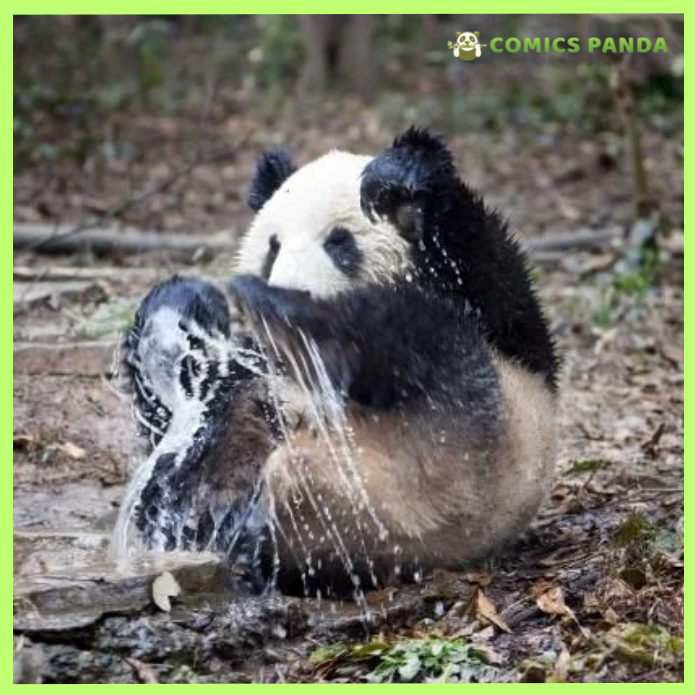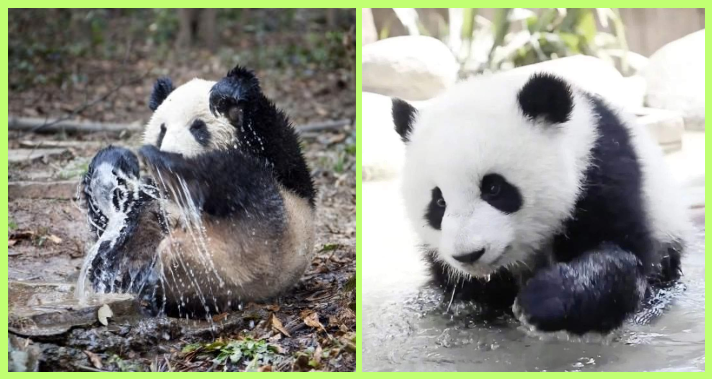Panda lives in the areas where the land is filled with hills, deep valleys, rocks, and tall forests. These mountains receive substantial amounts of rain and snow all year long. As a result, clean water rushes through numerous streams, rivers and tiny pools. Pandas rely on these natural water sources to get their water. Their home has a lot of places to drink, but discovering the best places to drink means that one needs to know the land very well. The forest is dense and water may be hidden under the bamboos or behind rocks. Panda spend their life within these areas learning the paths, remembering where there is fresh and safe water. Their movement in the day is often in the direction of the sound of running water or the smell of damp soil.
How Pandas Find Clean Water
Bamboo does contain some water, especially fresh shoots and leaves but not enough to provide a panda with a complete re-hydration. Their diet is dry and they eat a lot throughout the day. This constant chewing causes them to get thirsty. Pandas must drink clean water frequently to aid in digestion, keep the body warm and the organs healthy. Hydration also helps pandas to remain active. Even though they are slow, their bodies work hard at breaking down the bamboo. Without having sufficient water, pandas would become weak tired and unhealthy. Clean water is vital in order to survive.
Pandas do not look for water randomly. They have good senses which tell them their way. They have a particularly good sense of smell. They can smell moisture in the air, the smell of wet soil and the freshness of flowing water. This aids them to locate streams that no one knew existed, or small pools. Scientists indicate that sometimes, when there is water flowing on rocks or dripping leaves, ill and well-known panda species are heard. Even a soft sound may cause them to head to a good drinking spot. Their eyes also help them to pick up shimmering reflections or dark areas of wet ground. These senses work together in helping the pandas to find clean water without wasting energy.
#1. Baby panda gets playful at bath time

Not all the water in the forest is safe to drink. Some pools will be filled with water that may be stale or filled with dirt. Panda’s careful and usually go for a clean and flowing water. Streams and minor rivers are their preferred sources since the movement keeps water fresh. Flowing water helps to remove dirt and does not allow harmful things to grow. This makes it healthier to drink. Therefore, pandas are often found near these streams, especially during the dry seasons; as they know that the water would be clean. Rain also makes temporal puddles. Panda occasionally drink from these, but only if the water appears to be clear. The sense of smell helps them to judge the safety.
#2. Panda relaxes in a pool and splashes water on itself

#3. So cute

Pandas have excellent memory where their habitat is concerned. They memorize the routes they walk, and the areas where they can find food and water. These memories are helping them to survive. When the panda finds a good stream, they tend to return to the same stream every day. If that water source runs dry during parts of the year, pandas know where the areas close by are likely to have some clean water. This knowledge is transmitted through experience to live safely in the wild. Their paths through the forest are not a random process. They are influenced by the need for bamboo and water. Pandas move at a slow pace, but with a mission, and often follow a path that takes them from areas where they are feeding to where they are drinking.
#4. Thinking of being productive

The mountains that the pandas live in can get hot during the day and very cold at night. Clean water helps pandas to control their body temperature. Drinking cool water always keeps them well hydrated on the warm days. During the summer, pandas will sometimes sit near streams in order to keep cool. The sound and sensation of the water helps to comfort them and keep them calm. In the winter season drinking water helps their body to work smoothly even in cold weather. Hydration makes their muscles strong and prevents them from getting health problems. Without enough water, their thick coat would not be sufficient to keep them healthy in extreme temperatures.
#5. Pandas love to hang upside down

#6. After eating a lot of bamboos

Bamboo is hard and rich in fiber and constitutes a large portion of the life of the panda: that is, stereotypically, it requires much time to digest. Their digestive system requires a lot of water in order to break it down. Drinking enough amount of water makes food travel through their stomachs and intestine without any pain. It prevents dryness and takes the strain off their organs and helps them to absorb nutrients. Even though bamboo is not a good source of energy, panda gets as much as they can. Water aids their body to efficiently process this limited nutrition. Without proper hydration, they can have digestive issues that will have effects on their survival.
#7. It’s rolling time

Panda do not like to travel long distances. Their energy comes mostly from bamboo which is low in calories. Because of this, they like to stay near some place where not only food but also water is readily available. Sometimes they rest beside the streams after their meal. Other times they prefer feeding spots near rivers so that they might drink as and when they want to. Their lifestyle is about saving energy so being close to water is beneficial to reduce unnecessary movements. This behavior also protects them from danger.
#8. Pandas love to enjoy in water

During the rainy seasons, there is plenty of water. Streams are stronger and there is plenty of fresh water everywhere. Panda drinks a lot and is always well hydrated. In winter, certain water sources freeze and panda may migrate to the lower regions that have flowing streams. Snow also becomes a food source of water. Pandas are occasionally known to lick clean snow to get fresh water when it is formed more difficult to find. This helps them to stay hydrated until they find their way to a flowing stream again. Their movement through the mountains is seasonal. They always chose the routes that would lead them to both bamboo and water.
#9. Pandas love to sit alone

Water prevents all the parts of a panda to be ineffective. It helps their muscles, bones, and organs to function. In particular it keeps their fur healthy, their eyes clear, and their digestion smooth. The hydration also influences their behavior. A panda with an abundance of water is more subdued, more active, and able to consume enough bamboo to survive. Without water, their health would decrease, and they would not be able to maintain energy well. This is why finding clean water is not a matter of daily routine. It is an important aspect of their survival and overall wellbeing.
#10. Is this cane organic?

Pandas are as dependent on clean water as well as bamboo. Their strong senses help them to find streams and fresh pools hidden deep in the forest. They select clean water that flows in order to keep themselves healthy, aiding in their digestion and also in maintaining their body temperature. Their lives are not complicated and are deeply linked with nature. Every path they walk, every resting place they choose and every day that they survive is determined by the search for food and water. Pandas teach us the importance of having clean water to live not just but to suffer and to be comfortable and peacefully in the wild.




